The
Tea House
Forrás:
http://ourworld.compuserve.com/homepages/jmassey2/teahouse.htm
Teakult,
a Terebess Online különlapja
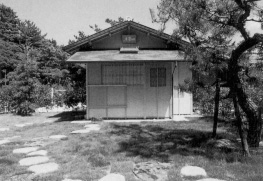
Shisui-an
tea house (Aug 94)
The idea of a separate tea house seems to have begun in the mid 1400's, but particularly by the time of Rikyu in the late 1500's the basic design of the tea house was established. Tea houses are unusual structures: sparse in design and furnishing, with strange doors and windows, and entered into through a garden that is purposefully planned to look unplanned.
The roji
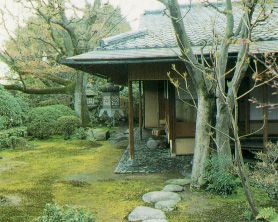
path
to Kandai (June 95)
The roji (literally "dewy path") is the garden area through which the guests walk to reach the tea house. It is painstakingly designed to simulate a rustic natural beauty through the use of grass, moss, stones, bamboo and a small wooden waiting area.
The tsukubai
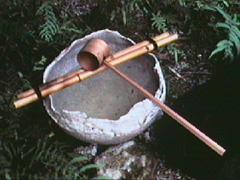
tsukubai
with hishaku
The tsukubai is a water basin which is found near the tea house. Guests use the tsukubai and oversized hishaku to rinse their hands and mouths in a ritualistic manner, more for a sense of purification instead of actual physical cleanliness. The water is warmed in winter, cool in summer.
The nijiriguchi
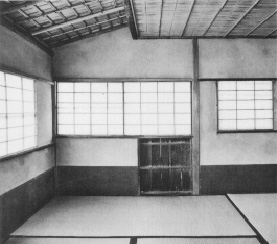
nijiriguchi
at Hasso-an teahouse (8/95)
The nijiriguchi is the guests' door into the tea house. It is purposefully placed above ground, and is less than three feet tall. After taking off their shoes, all the guests have to crawl into the room, regardless of social standing, in a manner reminiscent of the fetal position. This accentuates the distinction between the tearoom and the outside world.
The tokonoma
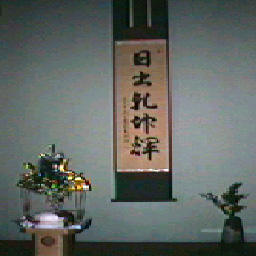
tokonoma
with display for New Year's tea ceremony
The tokonoma is the alcove found in every tea room. In the tokonoma are displayed scrolls, incense containers, special flower arrangements, and/or any other items appropriate to the occasion. In addition, any important tea items to be seen (but not used) in the tea ceremony will be placed there. Every guest stops at the tokonoma upon entering the tearoom.
The tatami
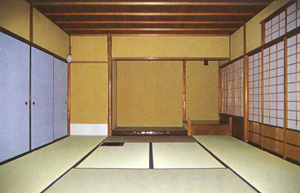
Grandmaster's
tearoom (Apr 99,12)
The tatami mats are made of woven reeds around a core which traditionally is rice straw, but which today is often styrofoam. Tea rooms have no furniture, and both host and guests sit with their legs bent beneath them in the seiza position. Tatami has just enough give to make sitting this way comfortable-- though many modern Japanese join Westerners in finding prolonged seiza sitting difficult to torturous.
The mizuya
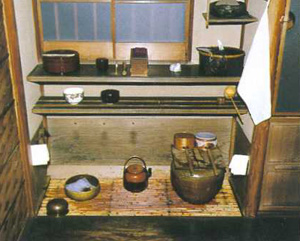
mizuya
with items (Mar 99,19)
The mizuya (literally "water room") is the preparation area, open only to the host and assistants, where the implements, kashi and matcha are prepared for presentation and use. Even though this area is not seen by the guests, care is taken to keep it as clean and orderly as the tearoom itself, and specific rules of "what goes where" abound.
Room design
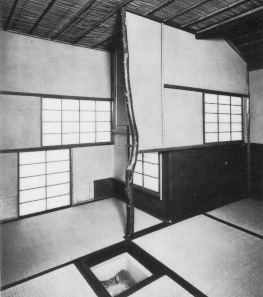
En-an
tea room (8/95)
There are a number of different tea room sizes and shapes, but the most common designs are hiroma and koma . Hiroma rooms have more than 4.5 mats (i.e., are more than 9 ft. square) and are generally designed more elaborately, while koma rooms have 4.5 mats or fewer, and are designed with a more rustic feel.
The temae
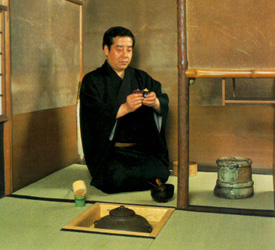
Omotesenke
grandmaster Jimyosai (1/95)
Temae is the word associated with the host, but the setup for the temae can be anything from a simple hirademae, where each item (other than the furo or ro) is carried in and placed on the tatami, to an elaborate daisu ceremony with huge shelving and every item displayed ahead of time. Guests view the temae area after leaving the tokonoma and before taking their places for the ceremony.